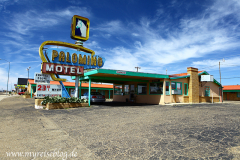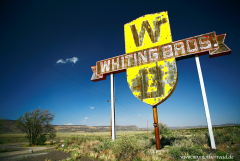Route 66 - History

Only dirt roads and trails crossed the US during the 19th century. Every state had its own road system. The economic boom brought the expansion of the rail roads. New lines were built alongside the old trails.
Then today’s interstates were built along the rail road lines and roads.
Every state having its own road system turned into issues at state borders. Roads often did not connect with those of neighboring states. Thus they led into nowhere
In the 20s this led to a committee of eight states who set out to build a connected highway system throughout the US.
Route 66 was born! First under the name of US 62 then it was approved as Freeway in 1926 under the name of Route 66.
It was completed in 1938.
The Great Depression drove more and more Americans West in search of a better life in the 1930s.
1934 brought the greatest surge of refugees – farmers and their families and workers fleeing the Dust Bowl of Oklahoma, Kansas, Texas and Arkansas to rebuild their lives in The Golden West – California.

Approximately 210.000 Americans left their homes in hope of a better life out West. Few of them found it.
Some of these refugees settled along Route 66 and tried their luck. Some of the diners and stores of those settlers are still there and in business today.
World War II brought another challenge for Route 66. War machinery and equipment had to be transported to the West. But Route 66 was not built for such traffic. It was too narrow and some bridges were too low. Route 66 had to be expanded.
After World War II the economy flourished again. Gas was not rationed. Tires were available. The new highways were marketed well. Articles about Route 66 its motels and diners were published throughout the country.
Route 66 turned into adventure combined with entertainment while driving cross country. A unique experience for tourists and locals.
Major attractions such as National Parks, State Parks and other road side attractions increased the number of tourists to the point that Route 66 could not handle the traffic any longer. A new highway system became necessary.

1953 Dwight D. Eisenhower was elected President of the United States. Building a new highway system was part of his agenda. Having experience the efficiency of the German Autobahn system he opted to follow this model.
Big interstates were to cross the country from East to West and North to South. East to West was identified by even numbers; North to South by odd numbers. For example I-40 runs from Wilmington, NC to Barstow, CA; I-25 runs from Buffalo, WY to Las Cruces, NM.
The construction of I-40 turned Route 66 into a subsidiary. When I-40 was completed in 1938 Route 66 was cut off from through traffic. In 1985 Route 66 ceased to exist officially.
Route 66’s motels and diners were lost in memory. Billboards were removed. Tourists stayed in new motels and ate in new fast food restaurants along I-40.
It looked like Route 66 fell into oblivion.

But myth and history of this road was not to be destroyed. After all Route 66 is and will be “America’s Main Street”.
1987 Route 66 Association was founded with the goal to never let Route 66 die.
Signes “Historic Route 66” started appearing along the road .
Today some of the old home steads, bridges, motels and diners have been identified as historic landmarks.
Thanks to the effort of Route 66 Association it will stay alive.
As often sections of I-40 were built over existing sections of Route 66, there is no continuous Route 66 today.
Many of the small villages have been cut off from through traffic.
As there are many who want to keep Route 66 and its myth and history alive there is lots of information about the original road available in form of books, maps, blogs and other media.
I want to show you my version of Route 66.
